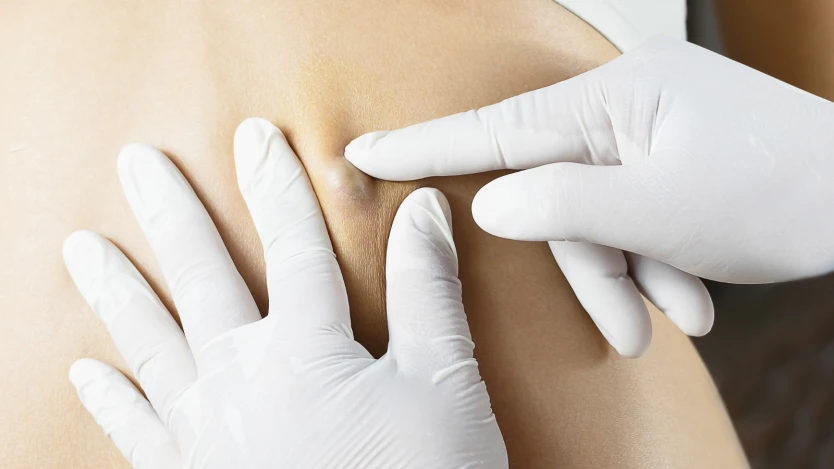Sebaceous cysts: what they are, how they form and treatment

- What is a sebaceous cyst?
- How do sebaceous cysts form?
- What is the usual presentation of sebaceous cysts?
- What is an infected sebaceous cyst?
- What is the treatment for a sebaceous cyst?
- Sebaceous cysts form on the inside of the skin and are covered by the skin.
- The origin of sebaceous cysts can be congenital, being born with them, or acquired, forming throughout life.
- The only definitive treatment for sebaceous cysts is surgical removal.
What is a sebaceous cyst?
A sebaceous cyst is defined as a cavity that forms inside the skin and is covered by the skin. It has a liquid or semi-solid content resulting from the formation of protein substances secreted by these cells and other cellular detritus. There is a great variety of cysts within this large aetiological group, sebaceous or epidermal cysts are the most frequent, although we can also find others on a regular basis such as millium cysts, pillar cysts and trichilemmal cysts.

Do you need surgery to remove a sebaceous cyst?
Request a free and immediate appointment with our specialists in general surgery
The difference between all these types of cysts is only possible by means of a pathological anatomy study, as it is necessary to see what type of layers cover it in order to be able to give it a name and surname.
Among the diagnostic suspicions that we must take into account when we come across a lesion suspected of being a sebaceous cyst are the so-called pseudocysts, which are cavities within the skin but which are not lined or surrounded by epithelial tissue, or lipomas, benign tumours or proliferation of fatty tissue that form small protuberances.
How do sebaceous cysts form?
Sebaceous cysts can have a congenital origin or be associated with alterations in embryonic development or on the other hand an acquired origin, i.e. their formation occurs during the development of everyday life for various reasons.
Congenital sebaceous cysts usually appear in the regions around the mouth and in the genital region and are due to possible alterations of certain epidermal remnants that become trapped during the development of the body in the early stages of the embryonic period.
Acquired sebaceous cysts form with adult development and are due to a variety of causes. It is now considered that any blockage of a part of the pilosebaceous follicle (body hair) may be susceptible to progress to the formation of a sebaceous cyst.
The production mechanism is caused by the obstruction of the outflow of the sebaceous gland content that accompanies the hair follicle. This obstruction leads to the accumulation of proteinaceous or sebaceous material inside the skin, which ends up forming a small capsule surrounded by epithelial cells, forming the sebaceous cyst.

What is the usual presentation of sebaceous cysts?
The external appearance of sebaceous cysts is a small protrusion protruding outwards from the skin that may or may not have a small pore in the centre with which it communicates with the outside.
As we have explained above, all cutaneous or skin cysts have their origin in any of the various portions that surround the hair follicle (the hair) in any part of the human body with hair growth. Depending on whether the sebaceous cyst starts to form in any of these parts, we will have different cysts with different characteristics.
They are usually firm to the touch, mobile and fluctuate in deep layers of the skin, so they are not usually found attached to layers further away from the skin surface. They tend to be more frequent on the trunk, face, neck, scrotum or behind the ears. In women, they may also appear on the external genitalia.

Do you need surgery to remove a sebaceous cyst?
Request a free and immediate appointment with our specialists in general surgery
What is an infected sebaceous cyst?
An infected sebaceous cyst is the consequence of an invasion of microorganisms through the skin into the contents of the cyst. This invasion of microorganisms into the contents of the sebaceous cyst allows the infective agents to proliferate and grow.

The human body detects the existence of these infectious entities and activates the immune system, producing inflammation in the area around the cyst. Therefore, in the presence of a cyst that has enlarged in size in the last few hours, is painful when it was not painful before, reddened and giving off heat, we should suspect the presence of an infected sebaceous cyst.
What is the treatment for a sebaceous cyst?
The definitive treatment for a sebaceous cyst is always surgical. Depending on whether what we have is a simple, non-infected cyst or whether it is infected due to the communication with the exterior as mentioned above, we will have one treatment or another.
If the cyst is infected we have two treatment options depending on the duration of the infection:
- If the cyst is indurated or reddened or is in the early stages of infection, treatment is usually by administration of analgesics or anti-inflammatory drugs and antibiotic treatment. In a very high percentage of cases these measures resolve the infective situation completely.
- If the stage of infection is more advanced and a purulent collection has already formed inside the sebaceous cyst, it may be necessary to evacuate the collection. This will require a cut and manual removal of the collection, as well as the addition of analgesic and antibiotic treatment. Once the sebaceous cyst is no longer infected, complete surgical removal is possible.

The treatment to completely remove a simple sebaceous cyst is surgical removal. To do this, it is necessary to make a small cut around the cyst and remove the cyst in its entirety. If we do not completely remove the capsule from the cavity that forms the sebaceous cyst, it is possible that it will reappear over time.
This type of operation usually has minimal complications; the only possible complications are slight discomfort in the hours following the operation. The surgery does not require hospitalisation; stitches are necessary, the number of which depends on the extent of the cyst.
Sebaceous cyst removal surgery usually lasts between 15 minutes and half an hour.

Do you need surgery to remove a sebaceous cyst?
Request a free and immediate appointment with our specialists in general surgery
Medical disclaimer: All the published content in Operarme is intended to disseminate reliable medical information to the general public, and is reviewed by healthcare professionals. In any case should this information be used to perform a diagnosis, indicate a treatment, or replace the medical assessment of a professional in a face to face consultation. Find more information in the links below:
